
Perge or Perga (Perge, ancient Greek name: Πέργη) is an ancient city, from which ruins now remain, which are one of the outstanding archaeological sites of Turkey.
The ruins of the ancient city of Perge (Perge Antik Kenti) are located within the borders of Aksu District in Antalya Province, 17 kilometers northeast of Antalya city center.
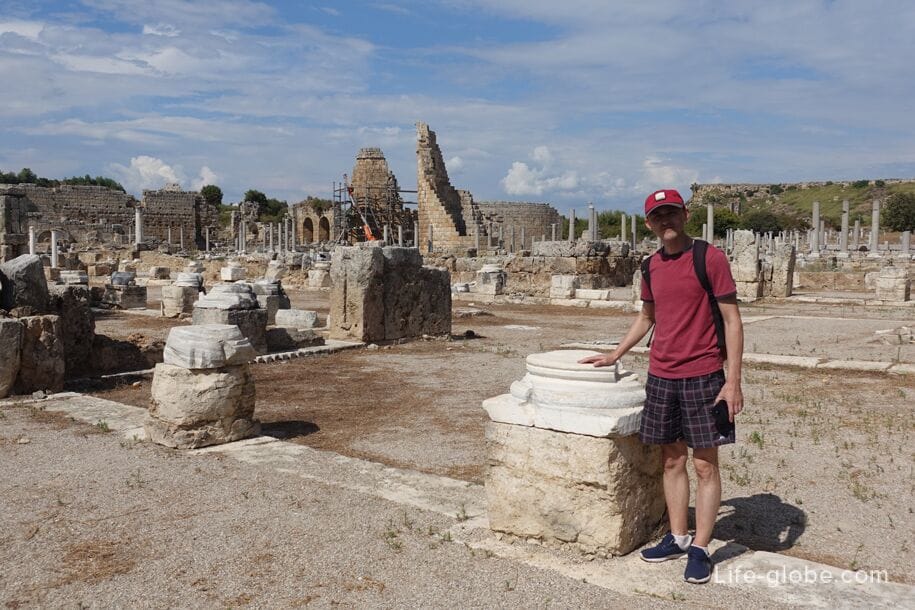
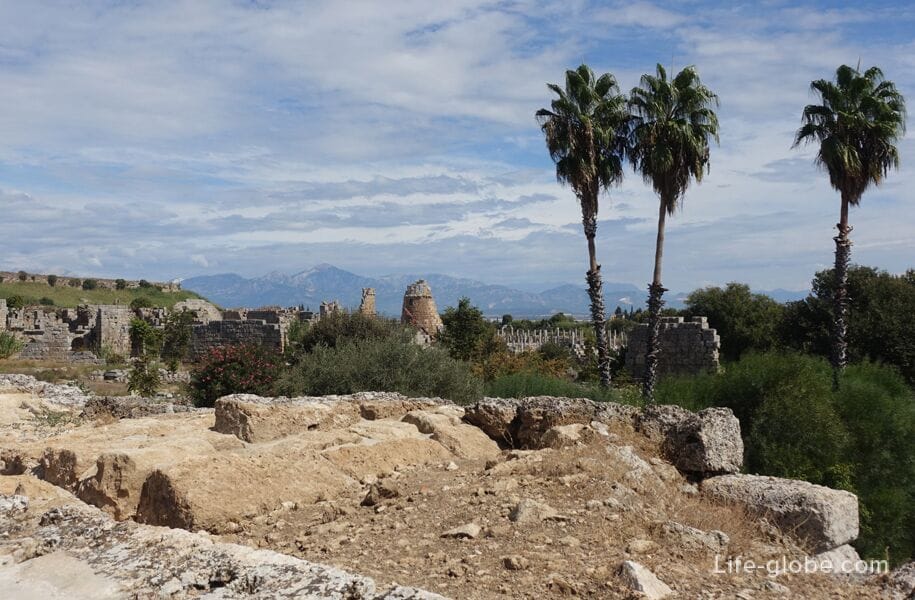
It is believed that the acropolis in the city was founded in the Bronze Age (4000-3000 BC). During the history of the city was a Greek colony, was under the rule of the Persians and Athenians. The region was conquered by the Romans in 188 BC. Under Roman rule in the 1st - 3rd centuries AD, Perge experienced the most brilliant period of prosperity with many magnificent buildings and structures, and was the most beautiful city in Anatolia, competing only with Side for the status of the most important city in Pamphylia. So, most of the remains of buildings that can be seen today in Perga belong to the Roman period.
In the first half of the 4th century, during the reign of Constantine the Great (324-337), Perge became an important center of Christianity, which soon became the official religion of the Roman Empire. The city retained its status as a Christian center in the 5th and 6th centuries. The Apostle Paul and his companion Saint Barnabas visited Pergia twice.
In the 7th-8th centuries, Arab raids led to the devastation of the city. By the arrival of the Seljuks in the 11th century, only a small village remained from the once rich city, which then completely disappeared, and the city turned into ruins.
Perge was the birthplace of its most famous native, the mathematician and geometer Apollonius of Perga, in 262 BC.
Since 1946, excavations have been carried out on the territory of Perge.
Since 2009, Perge has been included in the list of UNESCO World Heritage Sites.
Today, the ancient city of Perge, due to the importance of ruins and artifacts found during excavations, as well as the fact that it was one of the largest and most important ancient settlements preserved in general, is a treasure of Turkey and functions as an open-air museum. Some of the statues and sarcophagi found during excavations in Perga are now on display in The Archaeological Museum of Antalya, located directly in the center of Antalya.
On the territory of the ruins of Perge today you can see the remains of walls, gates and towers, basilicas, nymphaeums, baths, palaestra, propylaea, agora, some buildings and shops, the main street with a water canal, as well as an ancient stadium and theater.
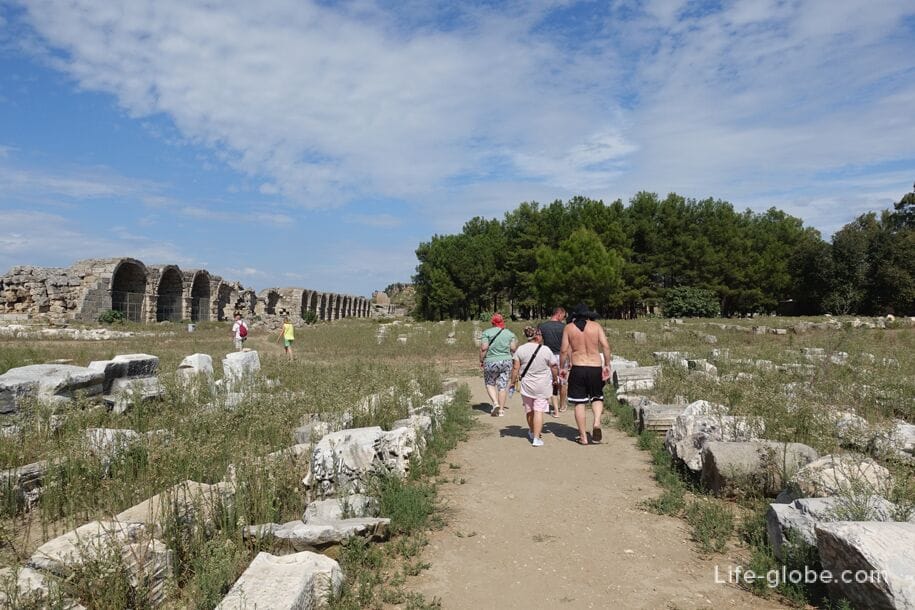
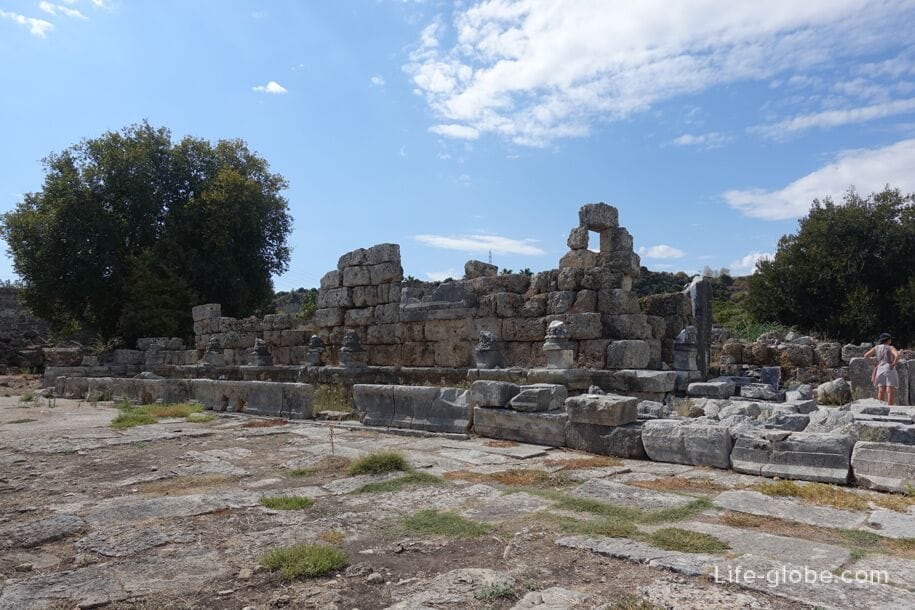
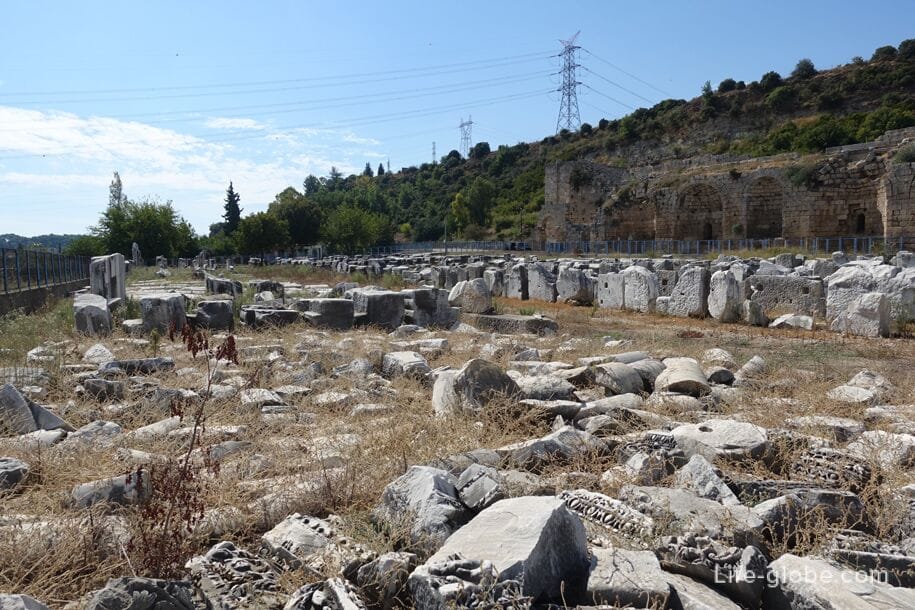
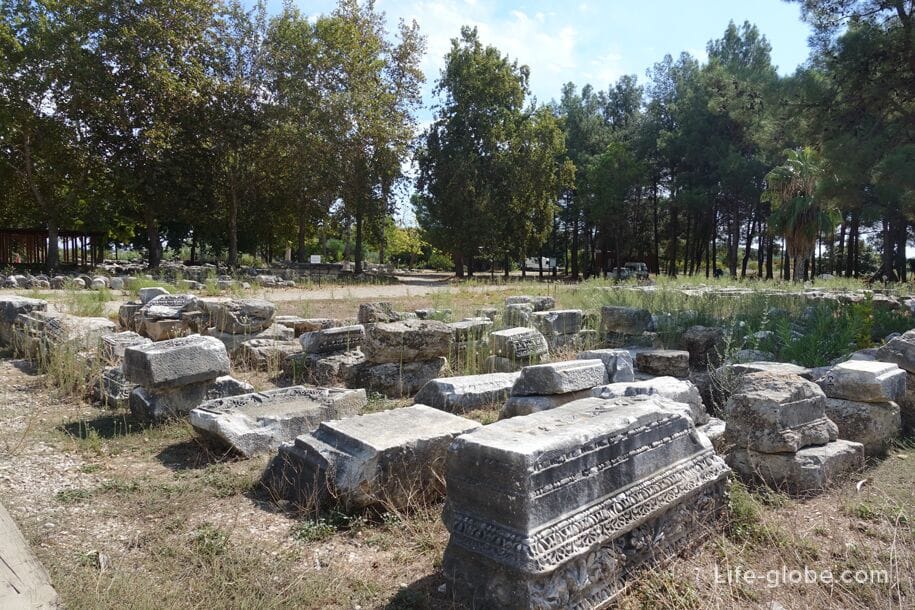
One of the most important buildings in Perge is the Roman theater (Perge tiyatrosu), dating from the second half of the 2nd century and designed for 15,000 people.
Здание сцены было декорировано мраморными рельефами с мифологическими сценами, в том числе изображающими жизнь Диониса, бога вина.
Территория сцены амфитеатра окружена перилами, что вероятно свидетельствует о том, что здесь также проводились гладиаторские бои и бои с животными.
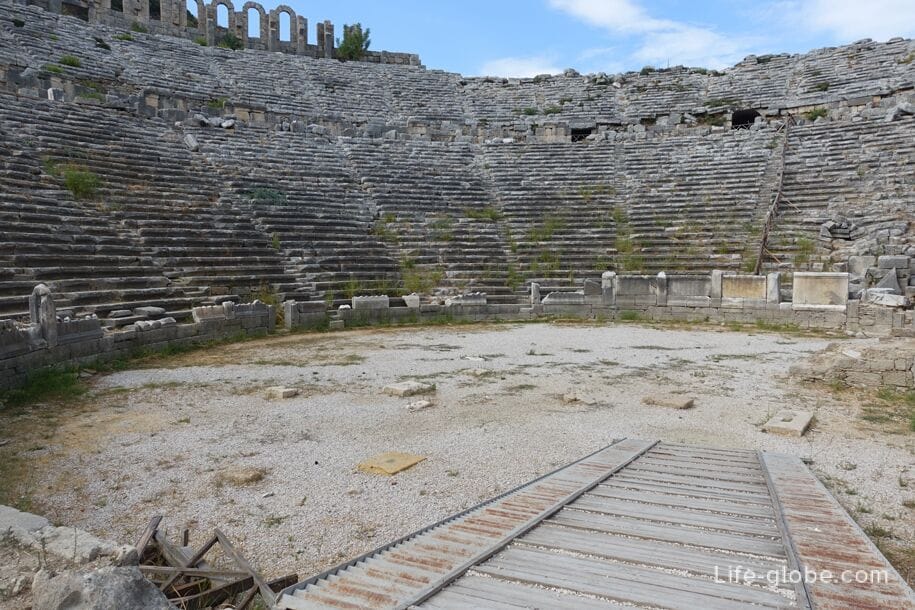
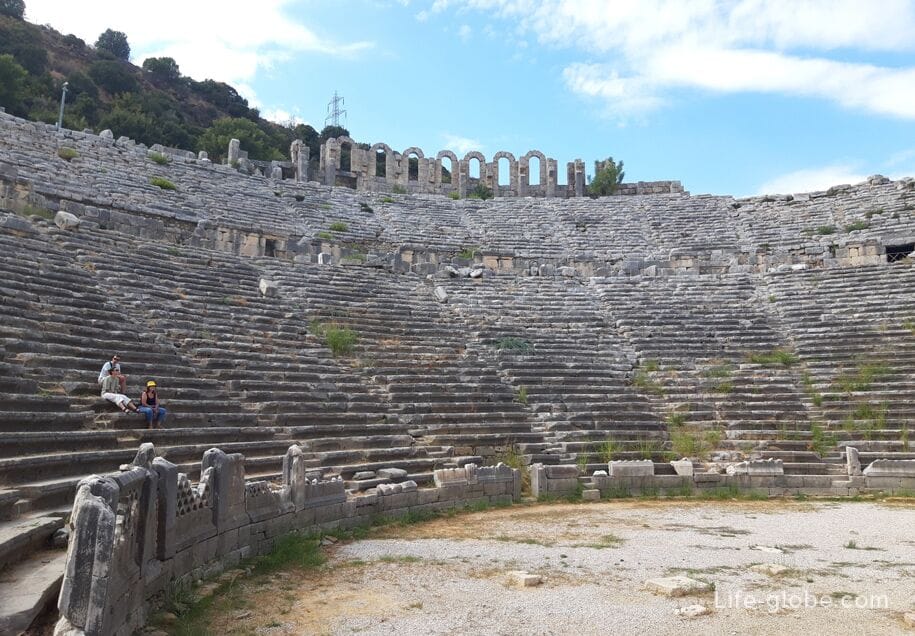
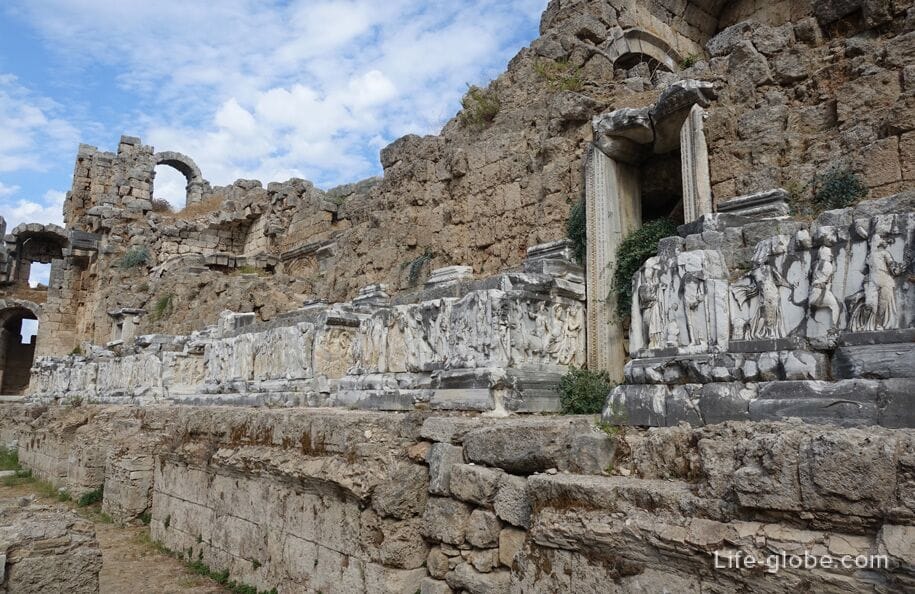
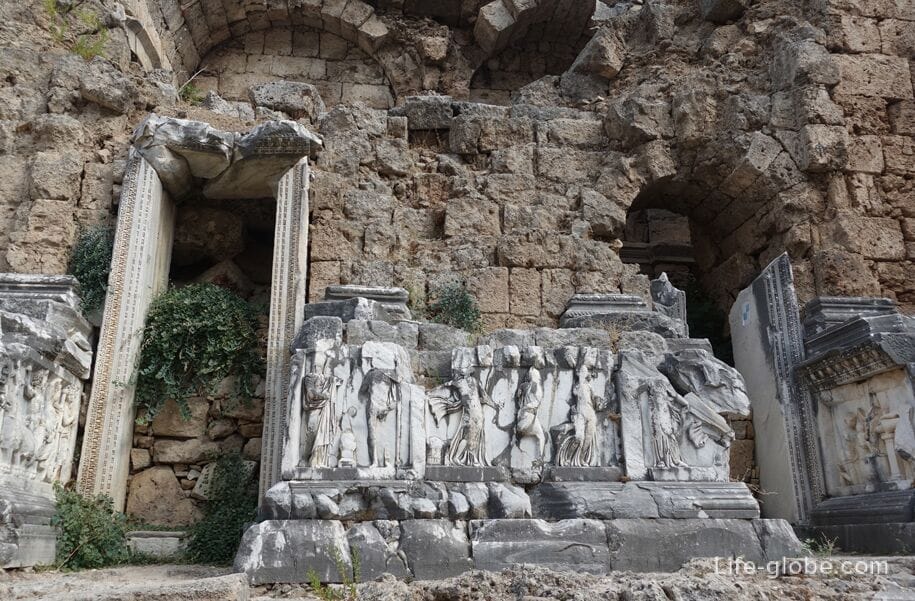
The theater is located across the street from the main and major part of the archaeological ruins of Perge.
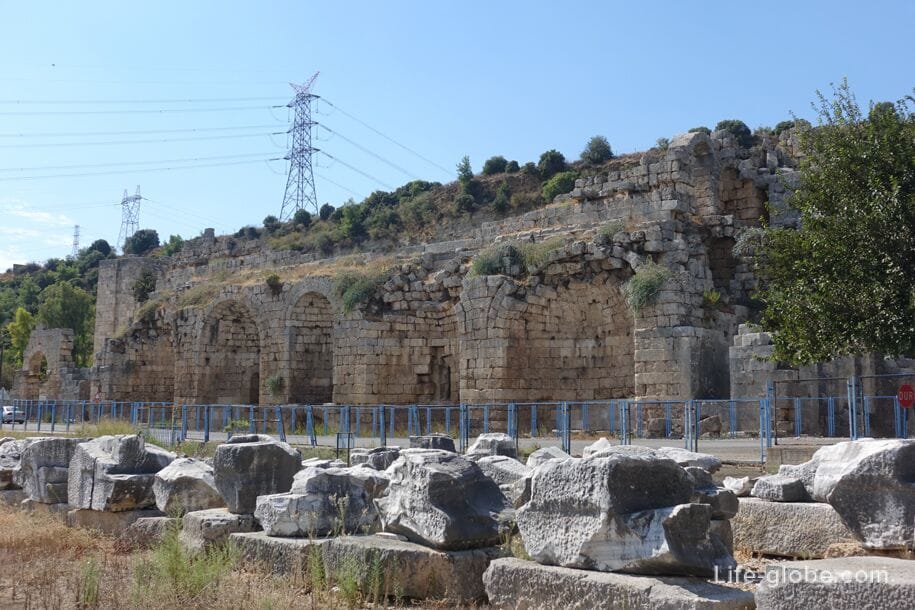
Another large structure of Perge is the stadium (Antikes Stadion Perge), designed for 12,000 spectators and is one of the best preserved in Turkey.
The width of the stadium is 34 meters, and its length is 234 meters.
The stadium had 12 rows, at the base of which is a vaulted structure. In every third cell of this structure there was an entrance to the stadium, and in the rest (deaf) there were shops.
In ancient times, sports competitions and races were held at the stadium.
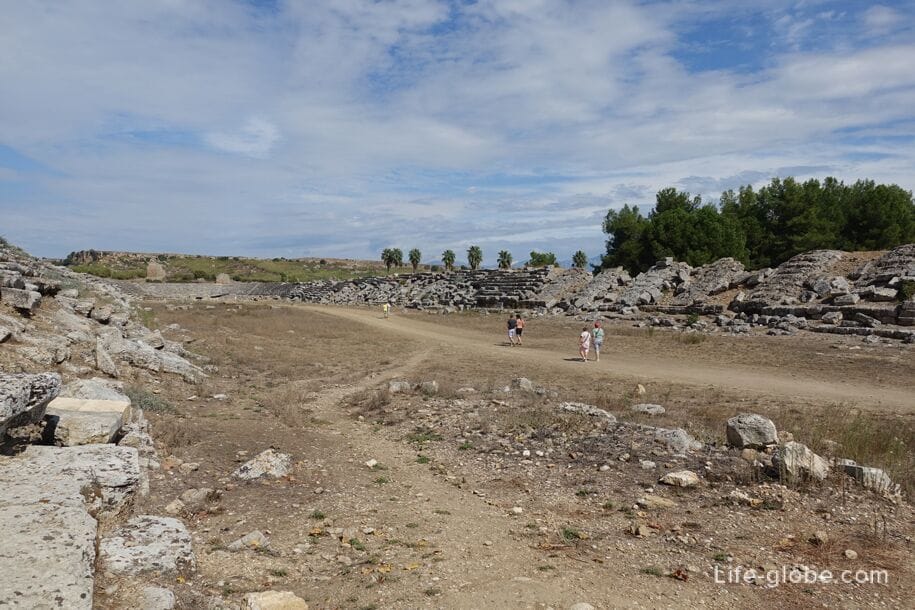
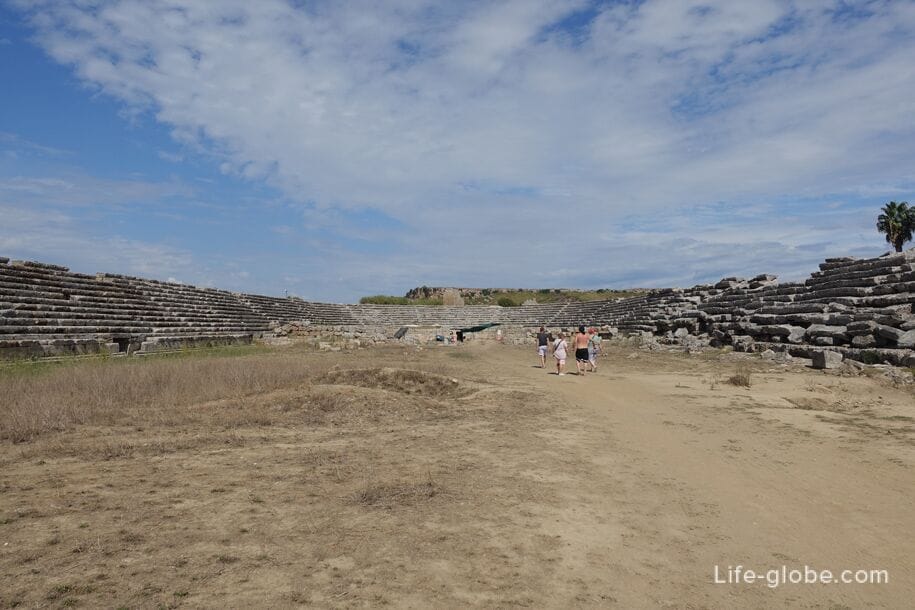
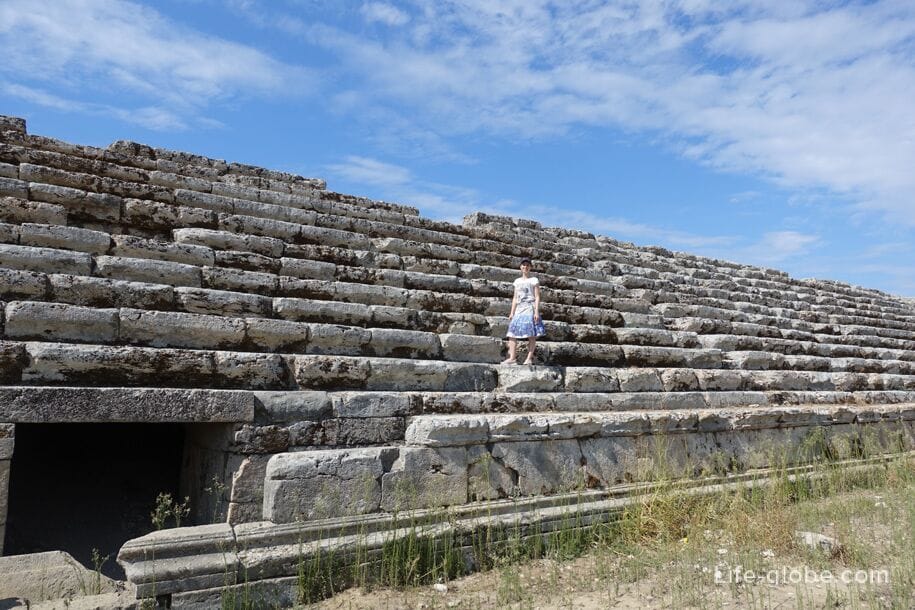
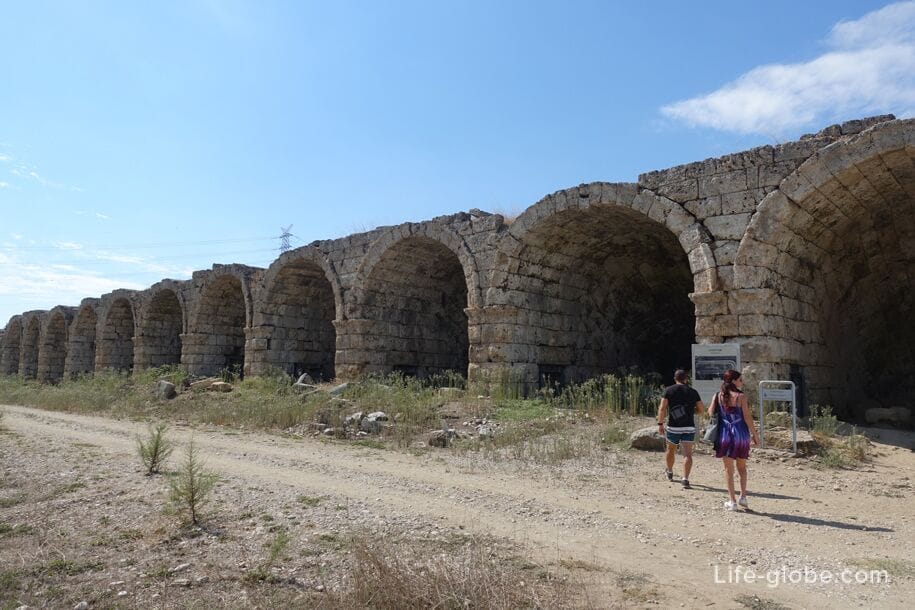
The remains of the city walls, which were 12 meters high and date back to the 3rd century BC. The walls had towers and 3 entrance gates.
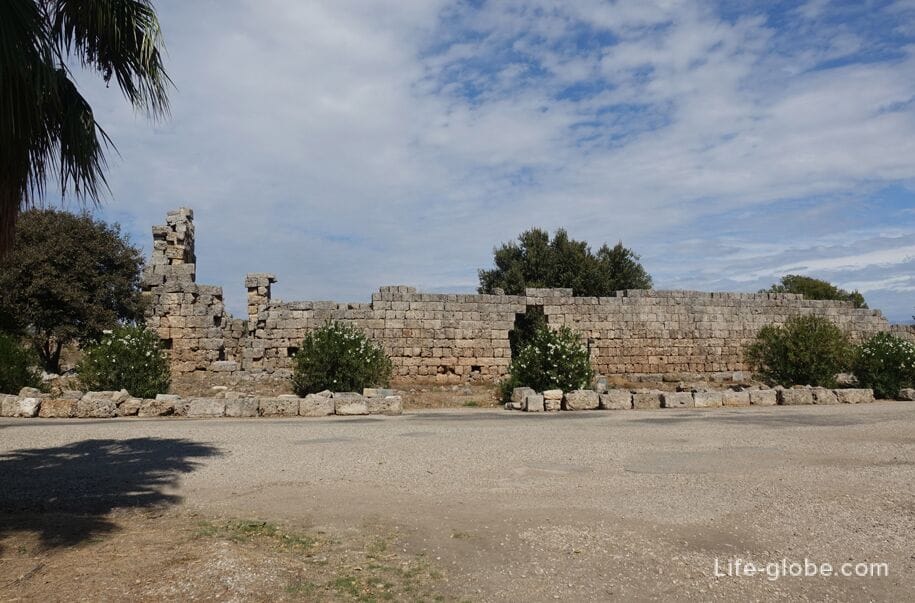
The southern gate, through the remains of which visitors enter the city today, is called the "Roman Gate" (Perge Roma Kapısı) and dates back to the 4th century. The gate was surrounded by two tall towers.
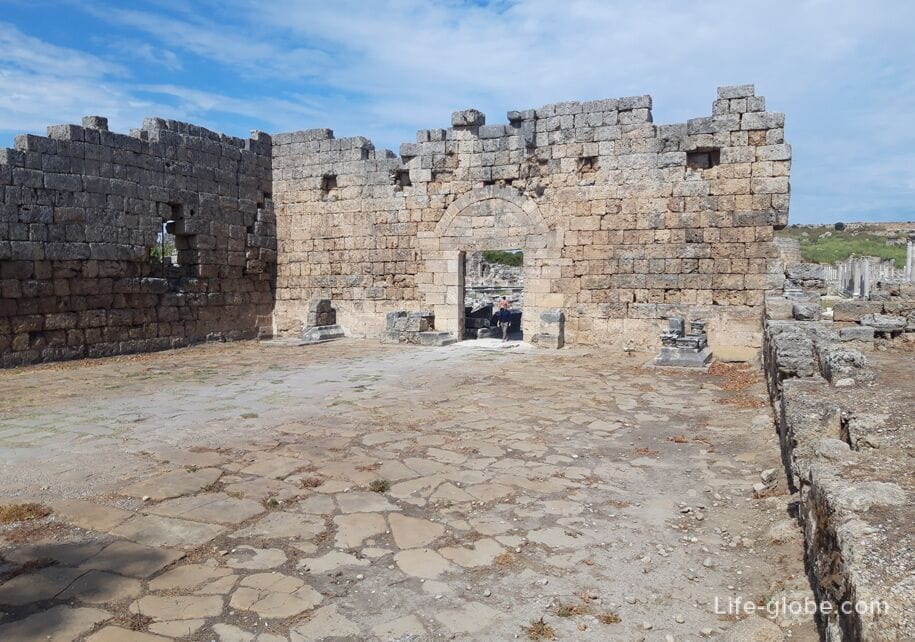
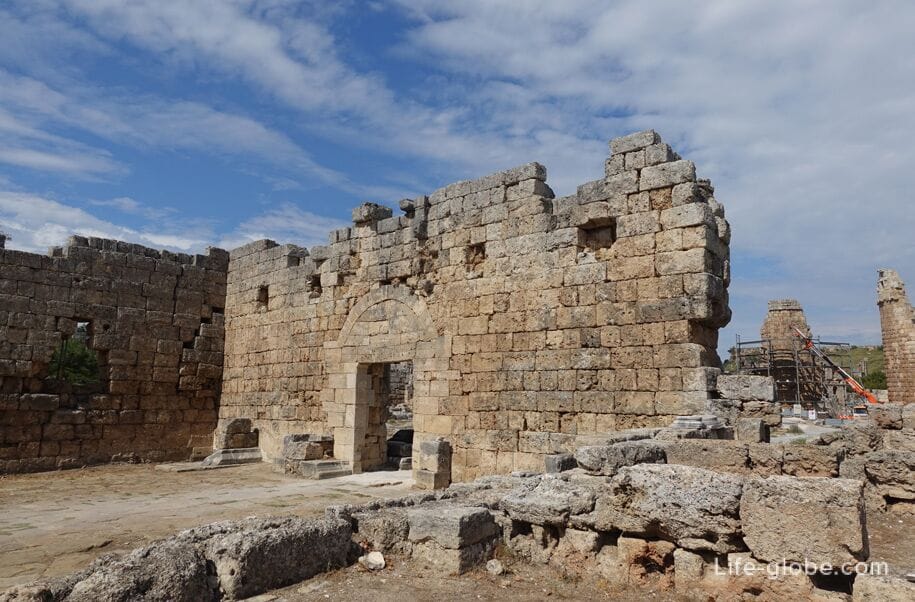
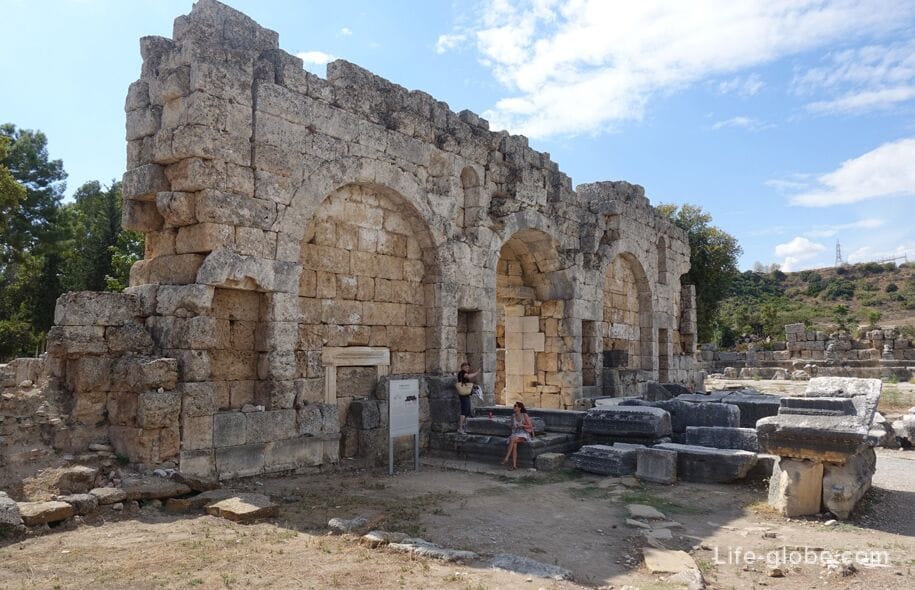
Remains of the eastern tower near the Roman Gate
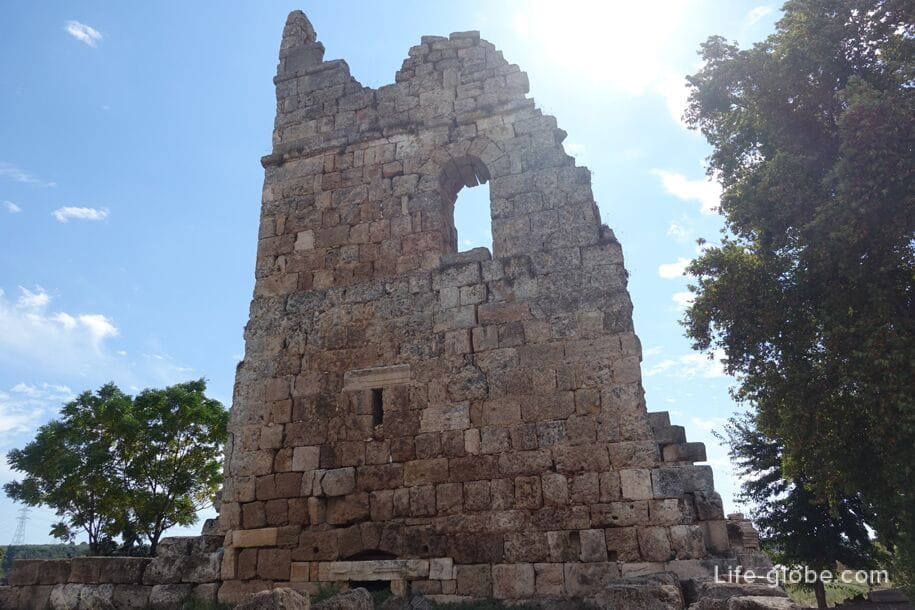
92 meters behind the Roman Gate are Hellenistic gate (Perge Hellenisyik Kapısı). These were the inner gates of the city (they were located inside the city, and did not lead beyond the walls), separating the so-called public part of Perge from the residential one.
The Hellenistic gate dates back to the 3rd century BC, but was rebuilt in the 2nd century AD.
The gate was framed by two rounded towers. The towers had 3 floors and conical roofs. These two towers are considered the symbol of Perge. Under Hadrian, in 121 AD, a triumphal arch was built into the northern wall of the courtyard of the towers (which is called "Hadrian's Arch"), with facades lined with precious marble and decorated with columns and statues.
Between the towers and the gate was a small U-shaped courtyard with niches in the walls. Excavations have shown that statues of gods, emperors and founders of the city once stood here.


To the west and east of the gates (Roman and Hellenistic) is an important part of Perge with the Septimius Severus Square, Nymphaeum, baths with propylaea, agora and basilica.
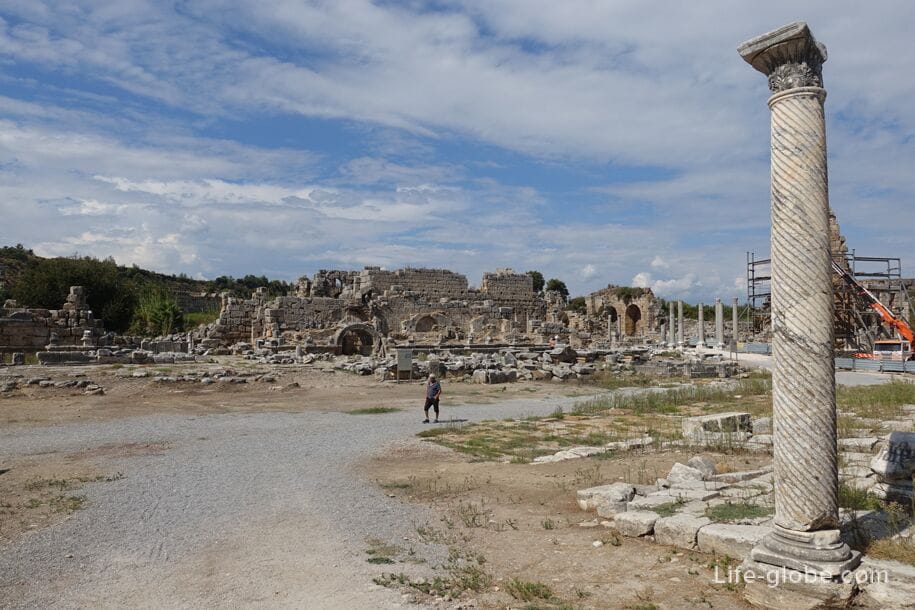
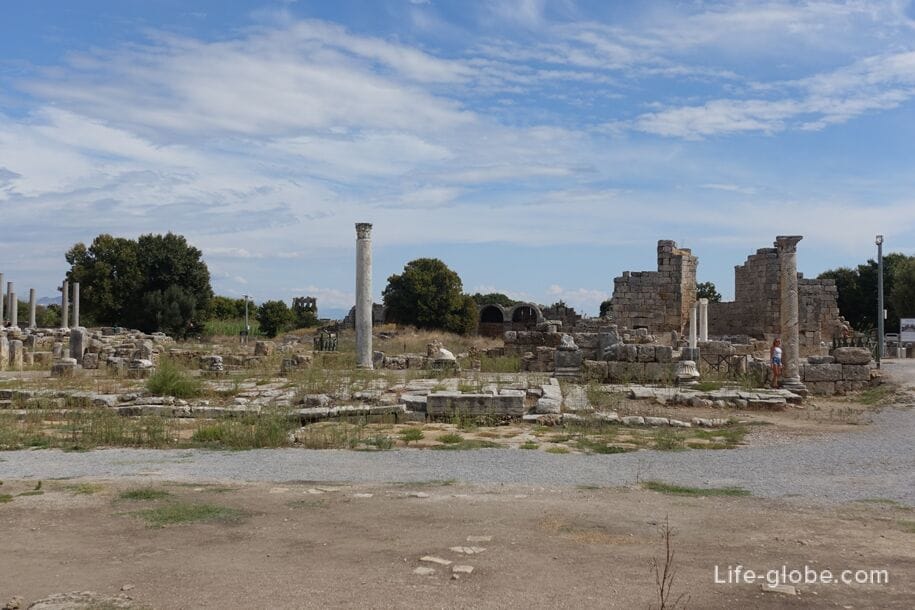
In the western part of Septimius Severus Square there are the remains of the nymphaeum, built in the late 2nd - early 3rd centuries AD.
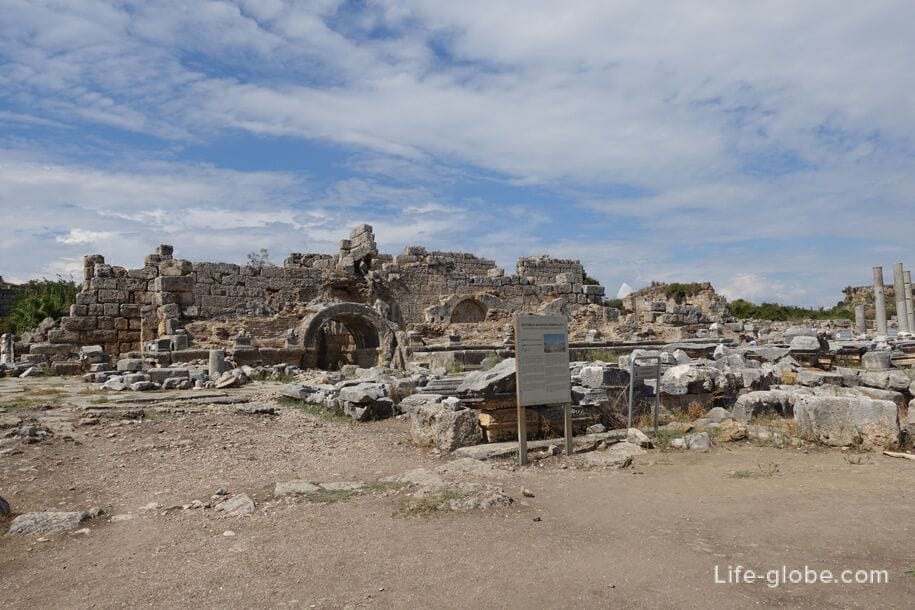
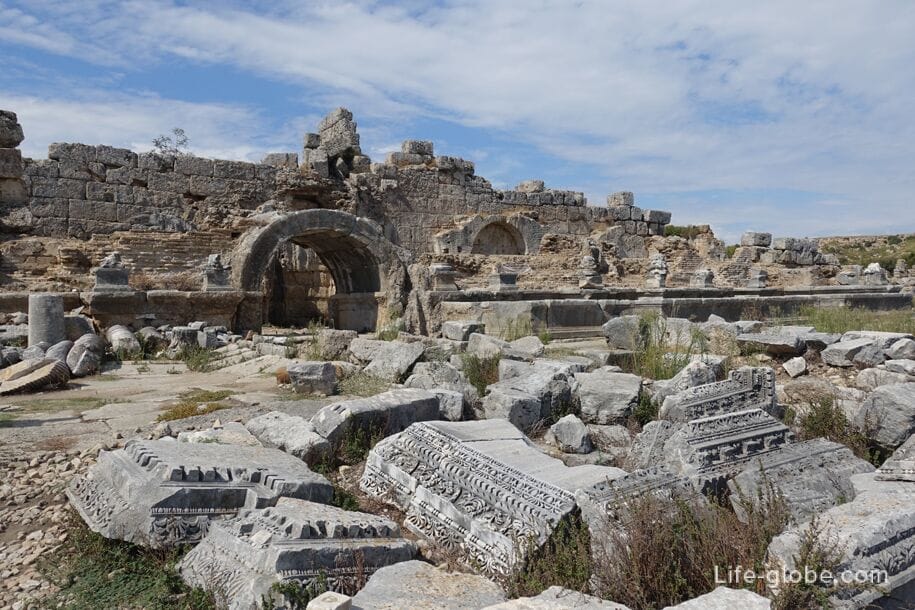
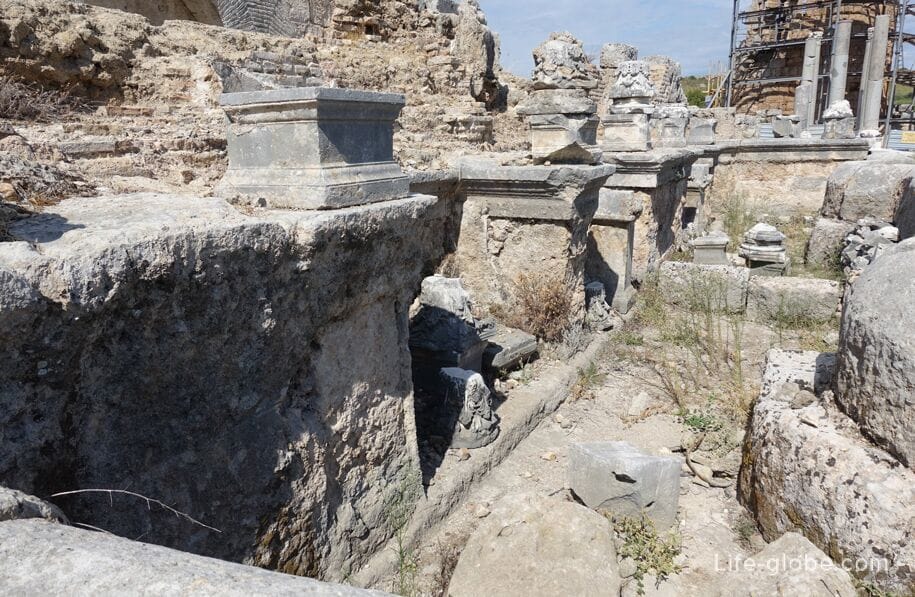
Behind the nymphaeum are southern baths (Roman baths, Perge Güney Hamamı), created in the I century AD. These baths were considered the largest bath complex in Pamphylia.
The remains of these baths are among the best preserved buildings and are notable for their size and monumentality, as well as a large collection of sculptures found there.
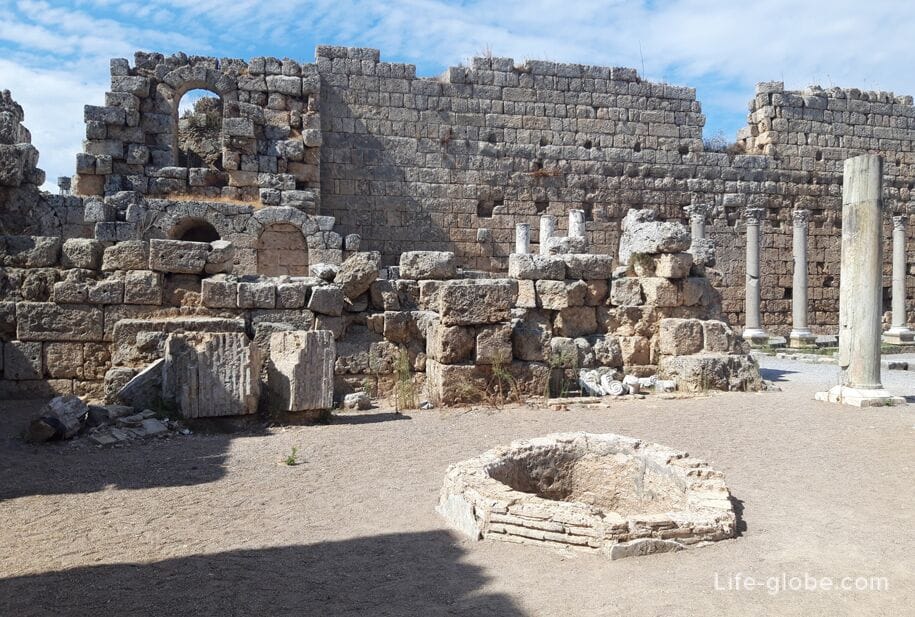
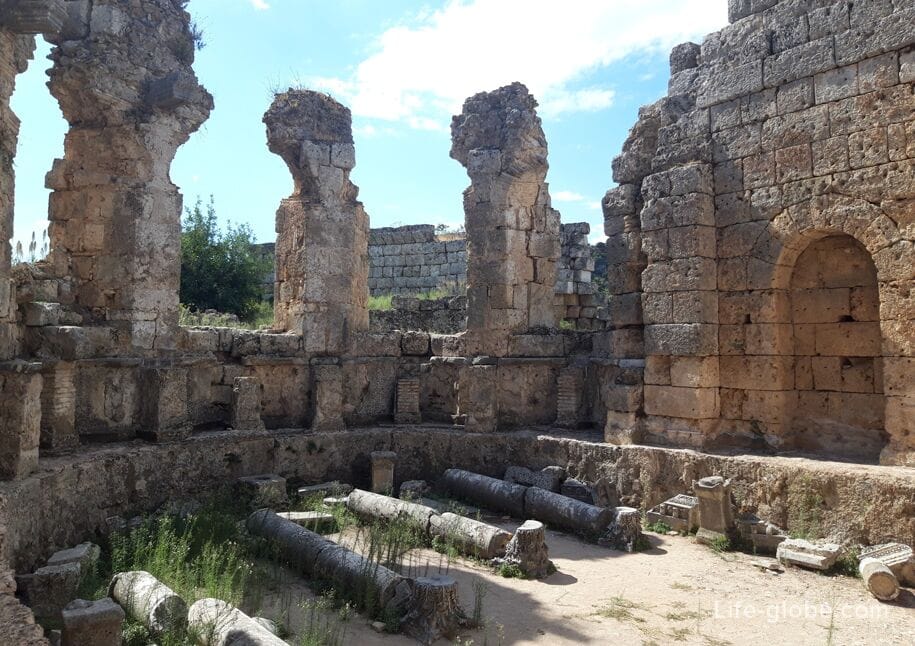


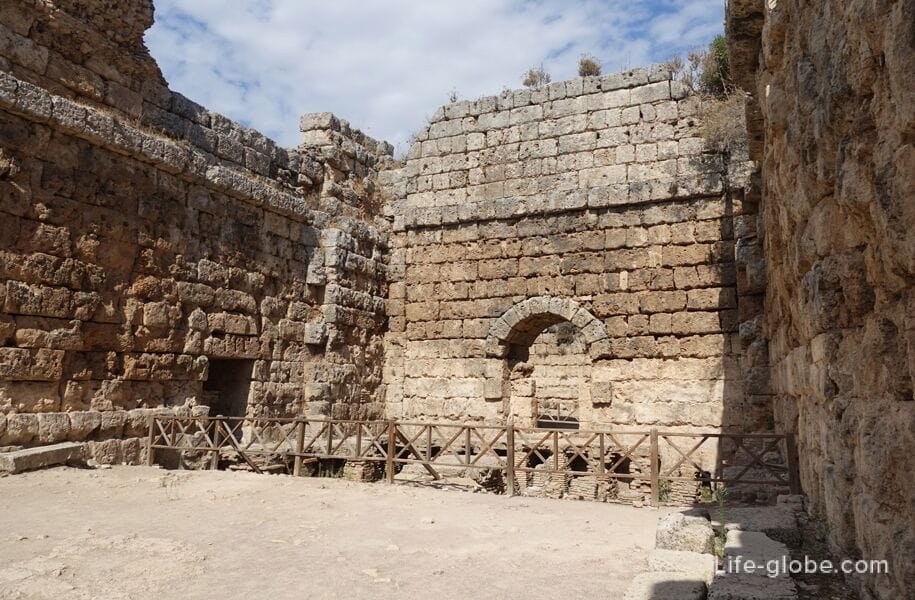
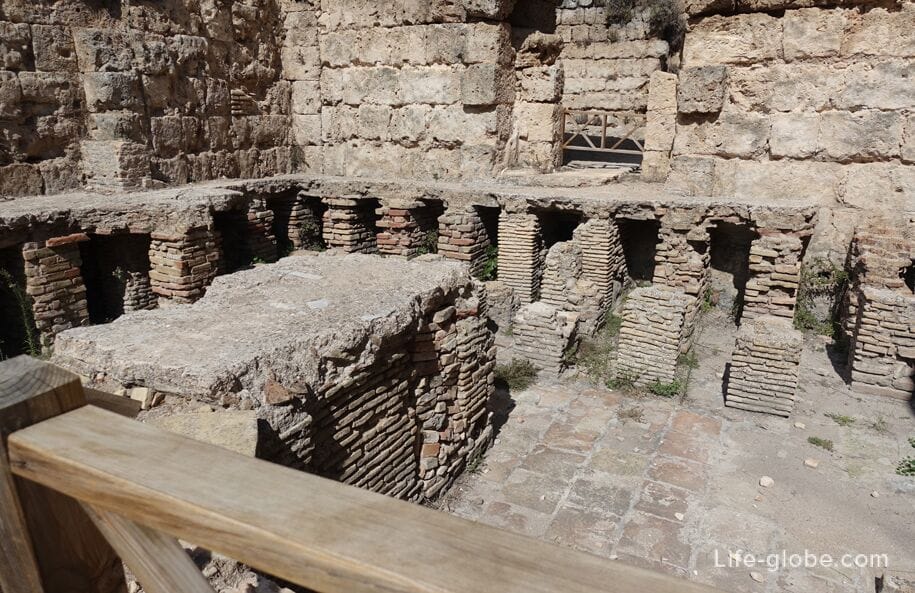


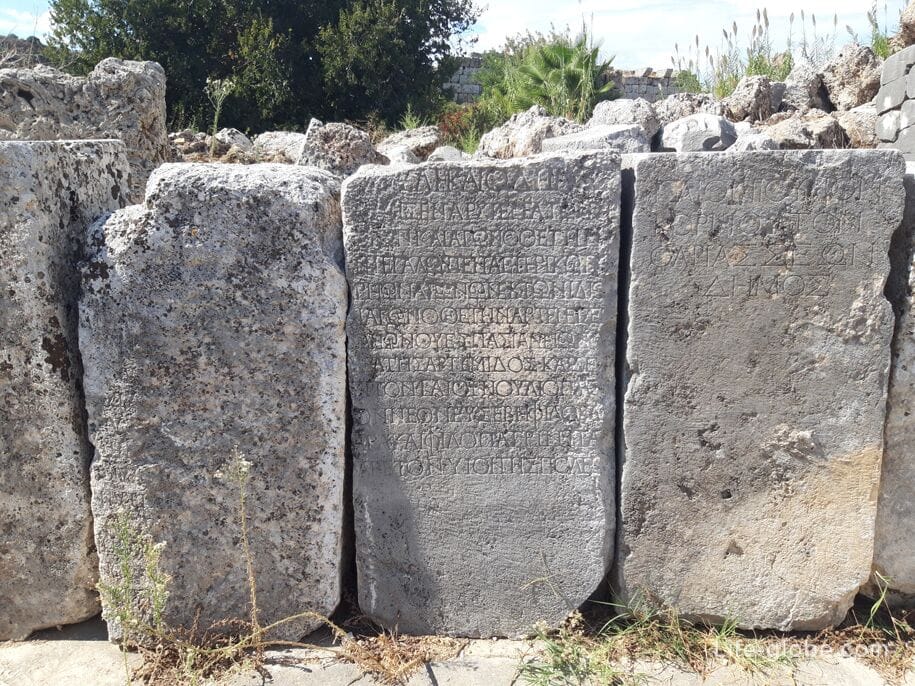
Once here, near the southern baths, there was a palaestra and propylaea.
Propylaea (propylon) is a monumental front entrance to the bath complex formed by porticos and created in the Roman period. Propylaea symmetrically decorated the eastern facade of the southern baths and were attached to the bath during the reconstruction of the oval courtyard. Today, only parts of the columns remain from the propylaea.
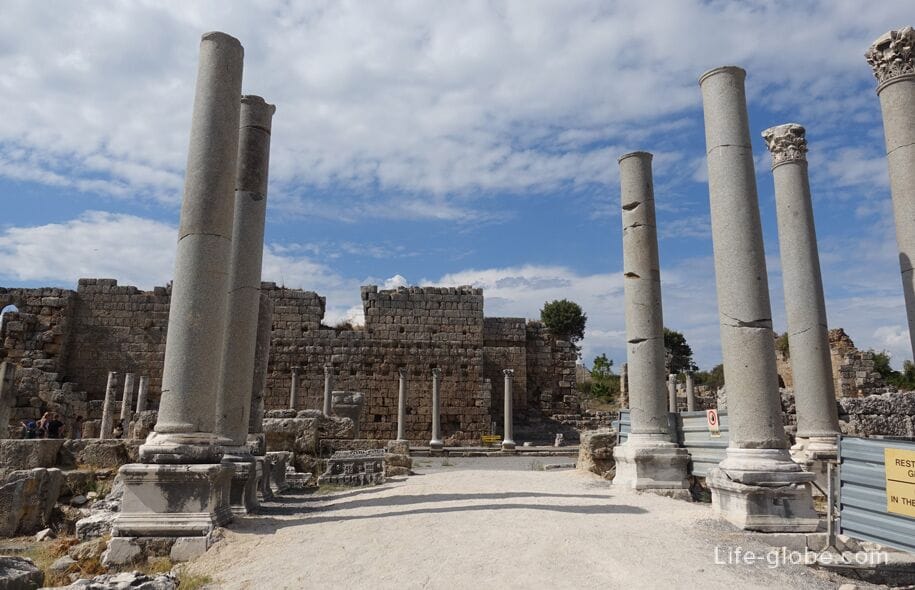

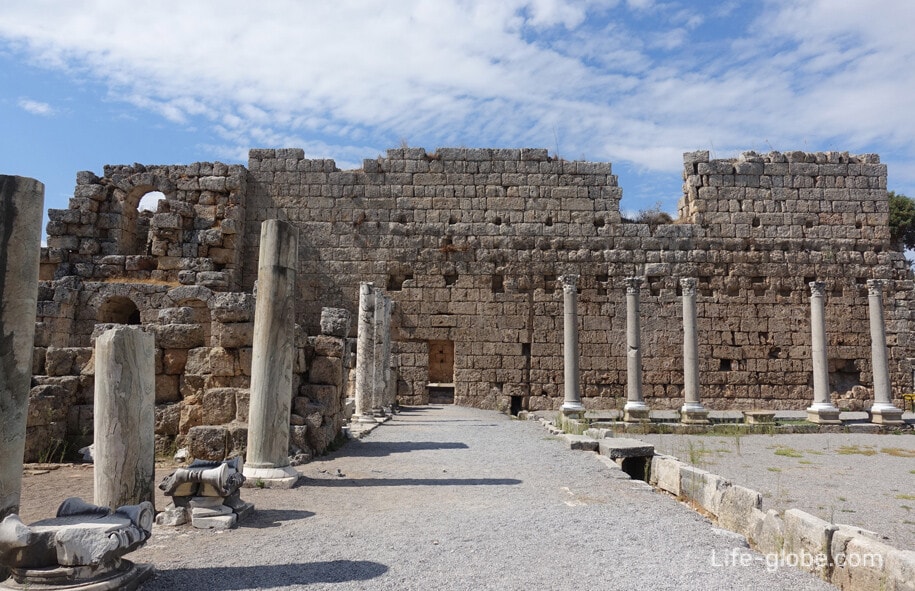
Scheme of southern baths with nymphaeum, propylaea and palaestra
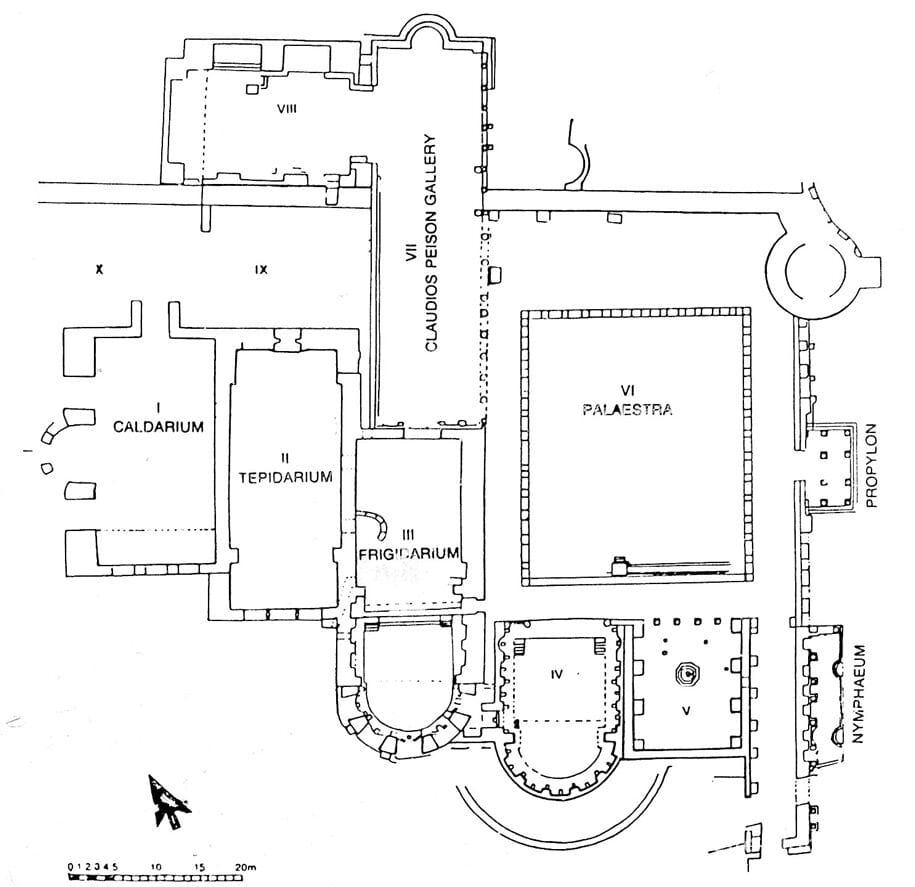
A little to the east of the Hellenistic Gate are the remains of the Agora - the central public, commercial and political space of ancient cities.
The agora was built in the 4th century AD, has the shape of a square with a side length of 51 meters and is surrounded by a colonnade.
In the center of the Agora has a circular structure with a diameter of 13.40 meters.
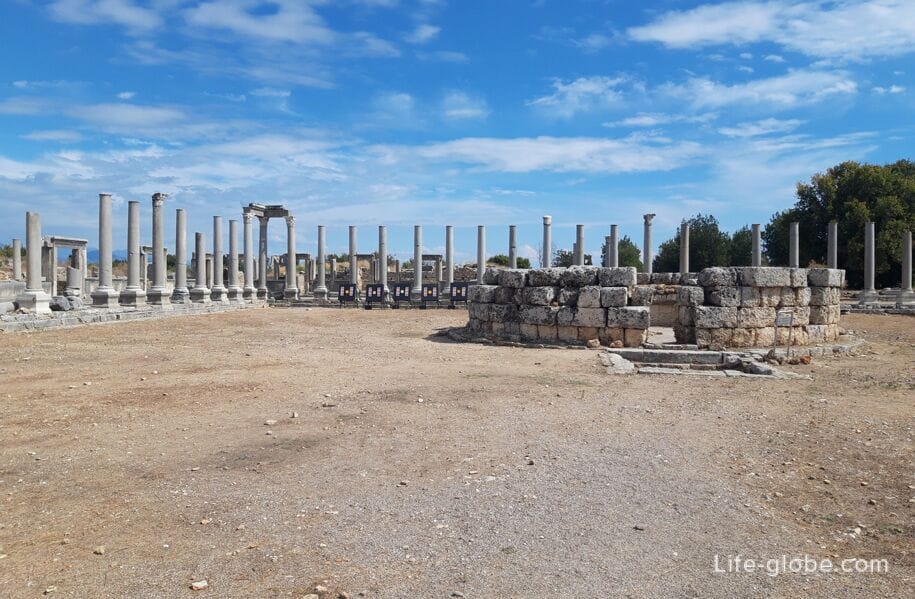
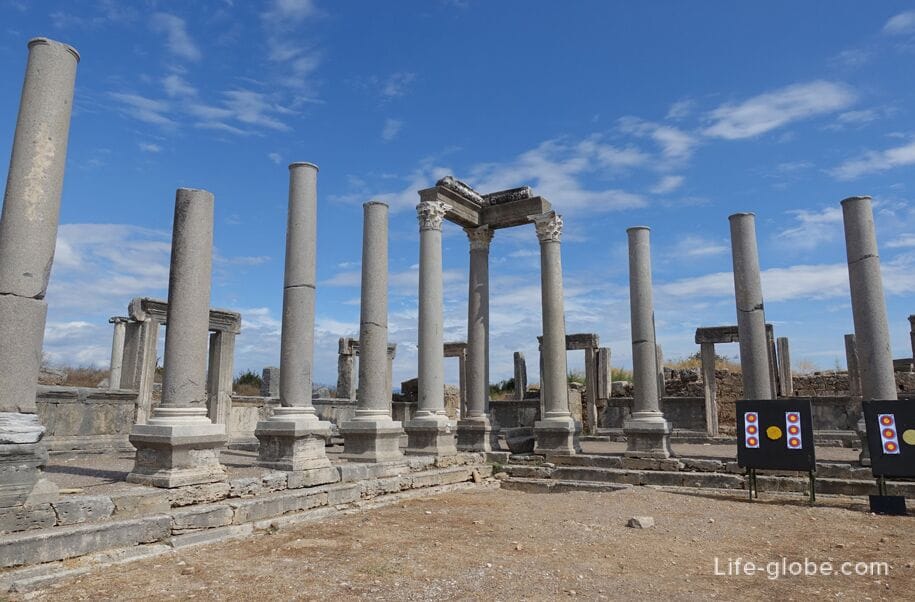
Once along the colonnade of the agora there were shops, parts of the ruins of which can also be seen today. The floors of some shops are covered with mosaics. Some of the shops face the agora, while others face the streets surrounding the agora. Depending on the slope of the ground, the shops in the south wing had two floors.
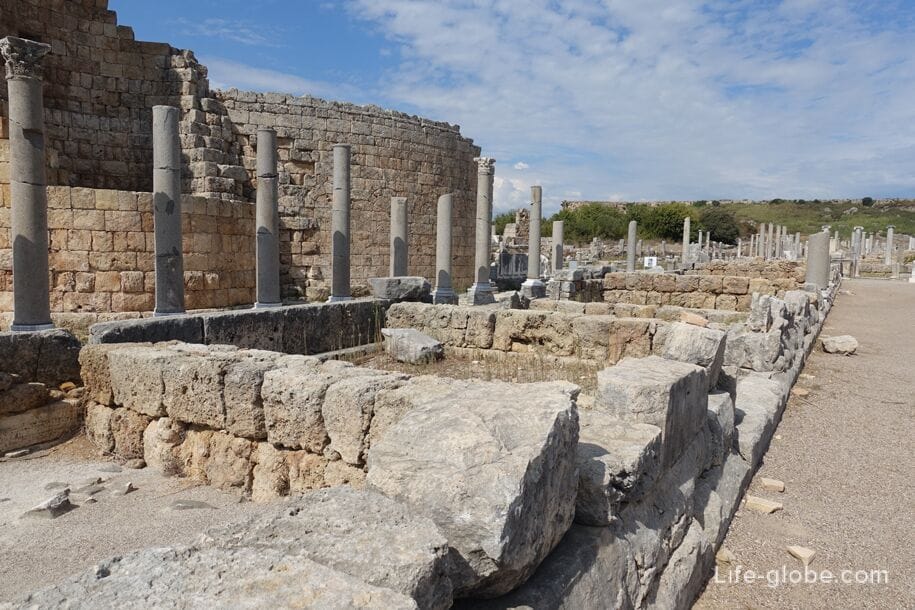
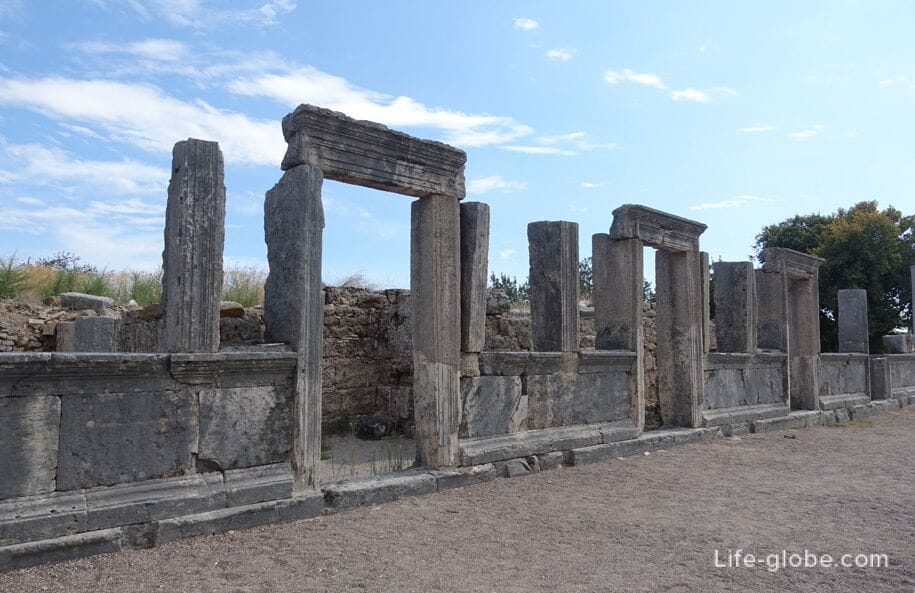
A little to the east of the agora, you can see the remains of the once majestic southern basilica.
After the adoption of Christianity by Constantine the Great in the first half of the 4th century AD, the new religion began to take the place of the old polytheistic religion throughout the empire. In fact, since the first century, when Christianity began to spread, Perge, as we know, has been an important city for Christians.
During this period, two large basilicas were built in Perga, the remains of which have partially survived to the present day. One is called the Southern Basilica and dates back to the 6th century AD, with preserved eastern walls and an apse. It is known that the basilica was cruciform, had three naves and a narthex, and the entrance to the basilica was provided from the east.
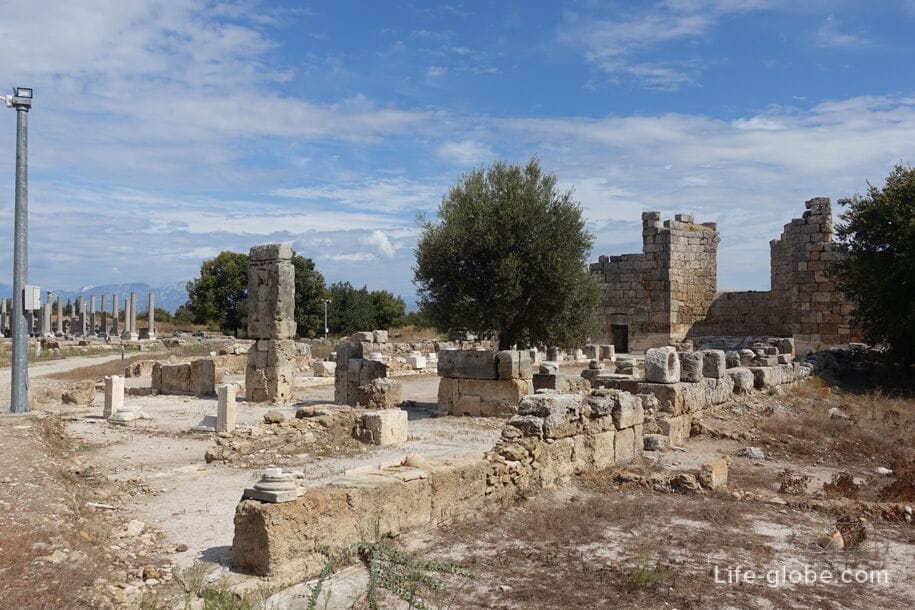

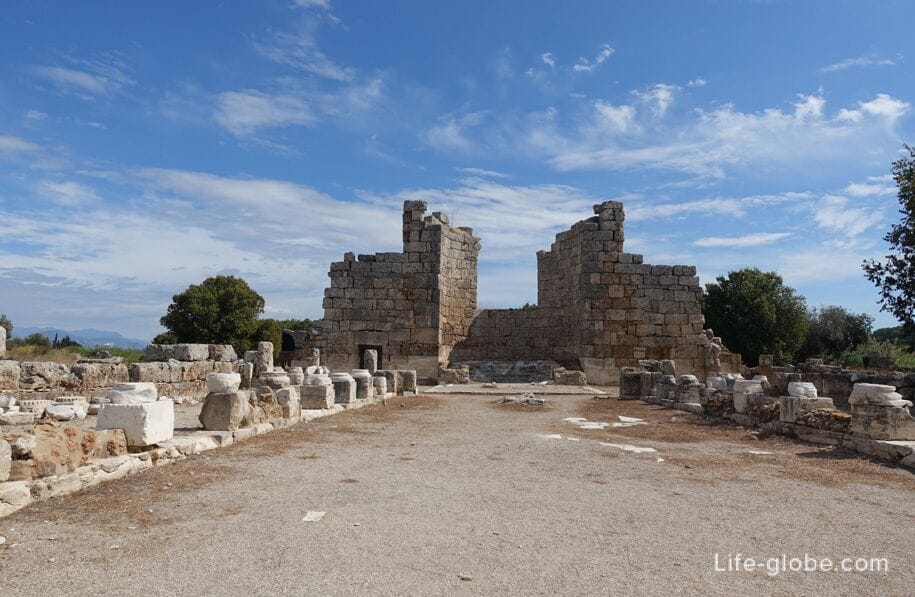
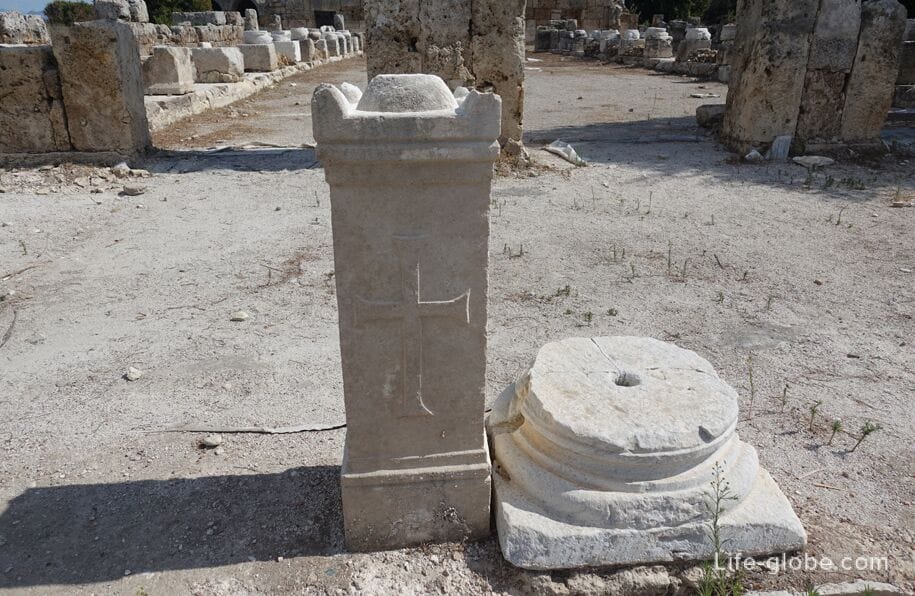
Behind the Hellenistic Gate (to the north) runs the central street of Perge - Column street (Perge Sütunlu Cadde), which has a length of about 300 meters and a width of 22 meters.
This street was one of the main axes of the city plan.
There are numerous columns on the street, from which it received the name "Column Street" or "street with Columns".
On both sides of the street there were shops, of which only ruins now remain. Behind the shops there were residential buildings and public buildings of the Hellenistic and Roman periods, there was also a basilica.

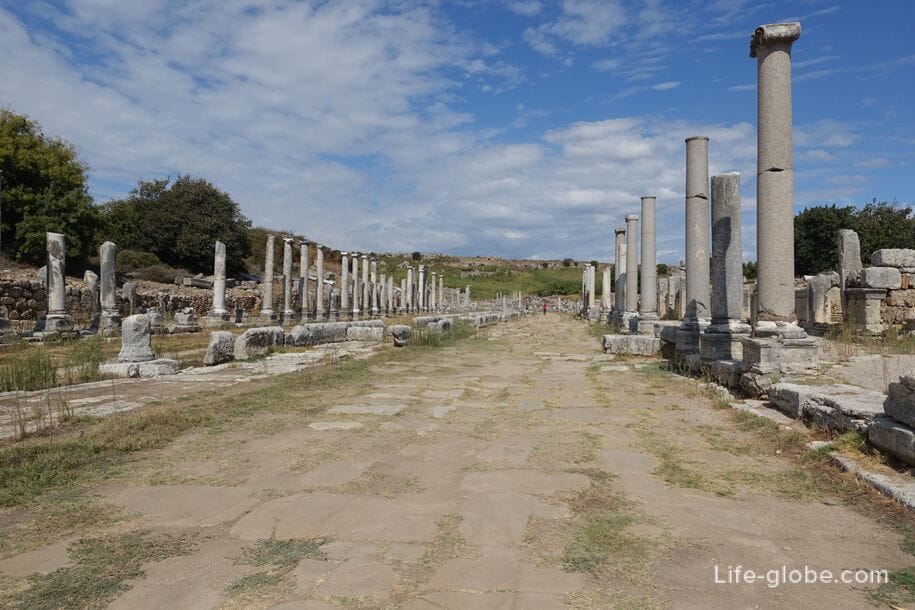
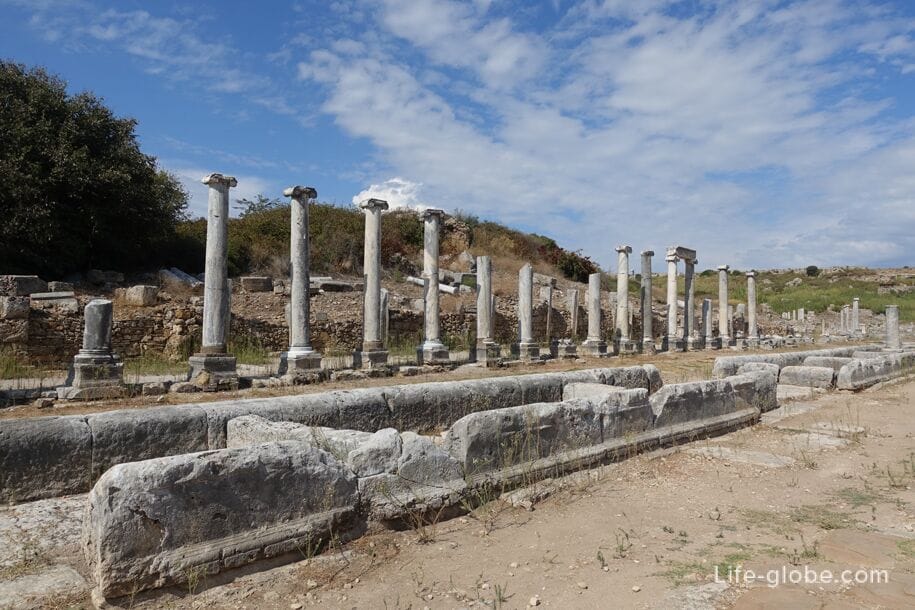

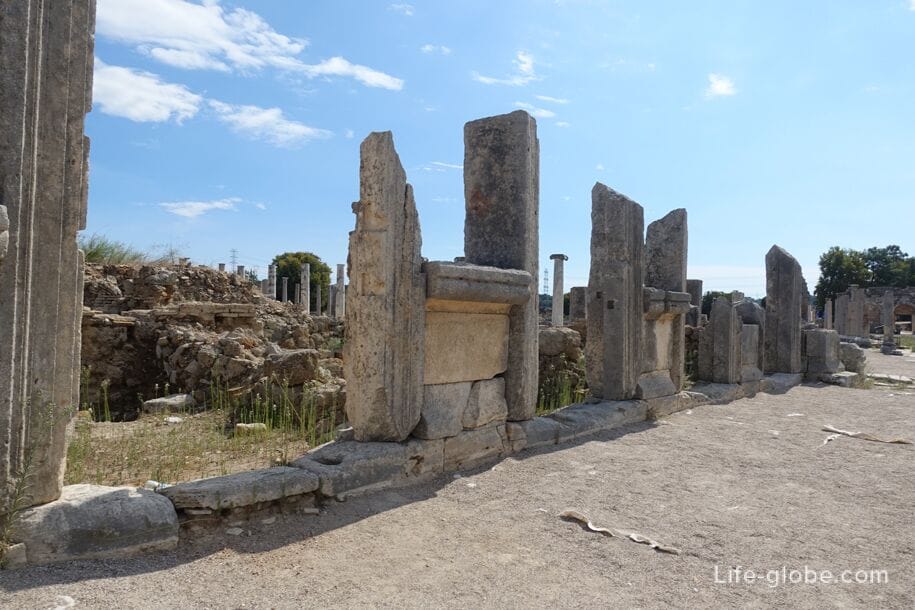


On Columnar Street, you can see small remnants of the mosaic.

In the center of the Column Street there was a water channel, which contained a series of cascading pools and supplied water to four monumental fountains and two baths in Perga, as well as shops along the street.
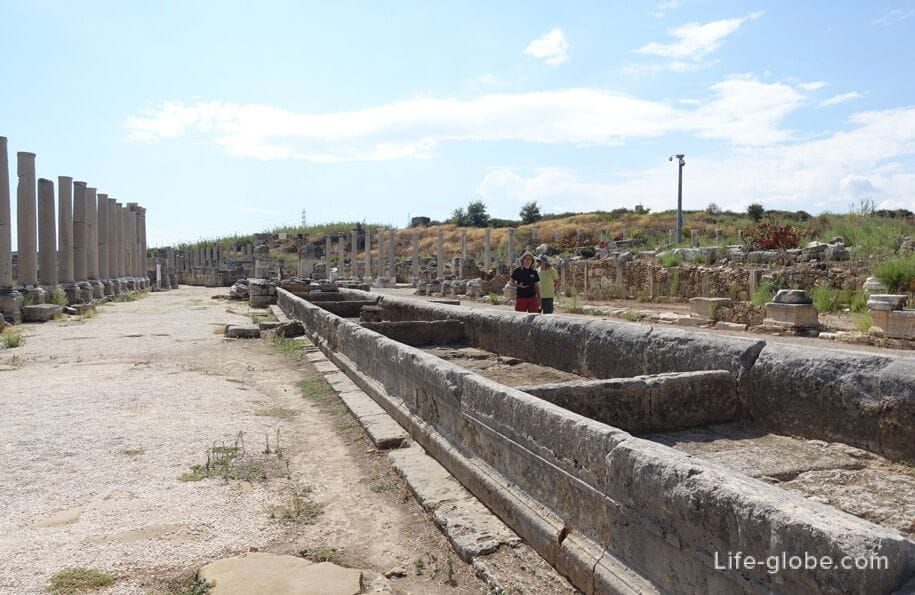
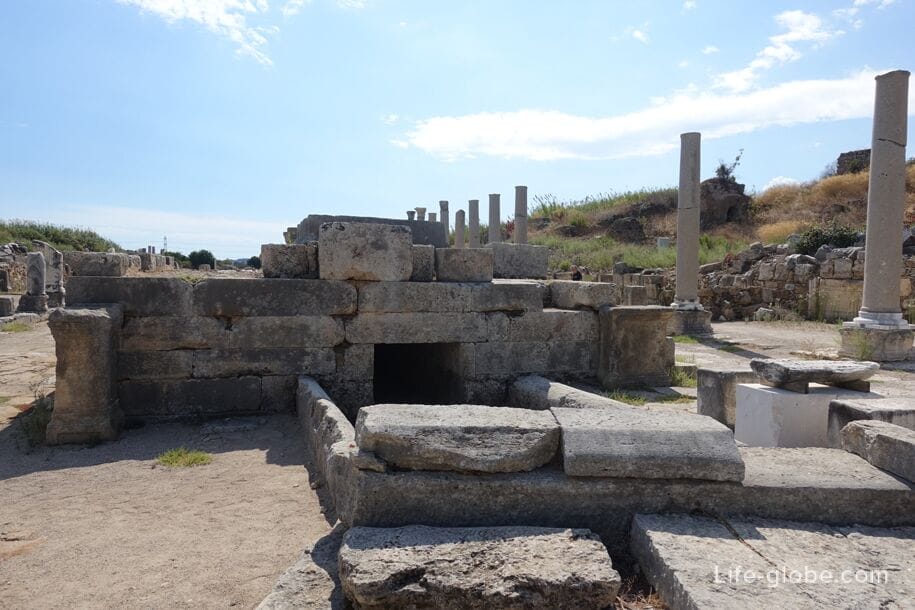
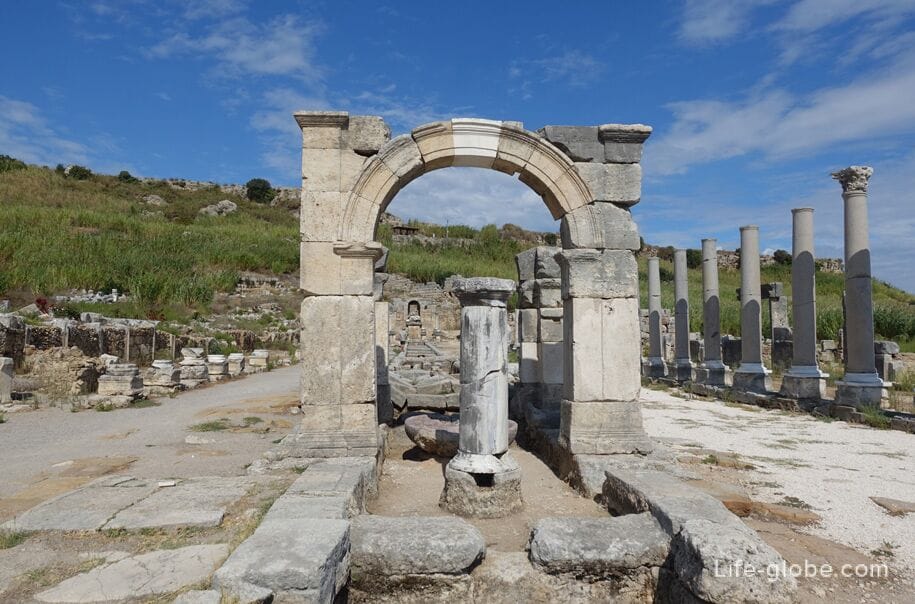
The central street ends with the Hadrian's era nymphaeum, known as the "Hadrian's nymphaeum".
Hadrian's nymphaeum dates back to 122 AD. It was beautifully decorated with numerous sculptures, including the river god Cestrus, under which water flowed. The Nymphaeum is located on the edge of the acropolis to catch the outflow of abundant water supply and from there feed the riverbed that flowed through the city.



Behind Hadrian's Nymphaeum, the ascent begins on a flat hill with acropolis with basilicas.
The structures of the acropolis are poorly preserved.
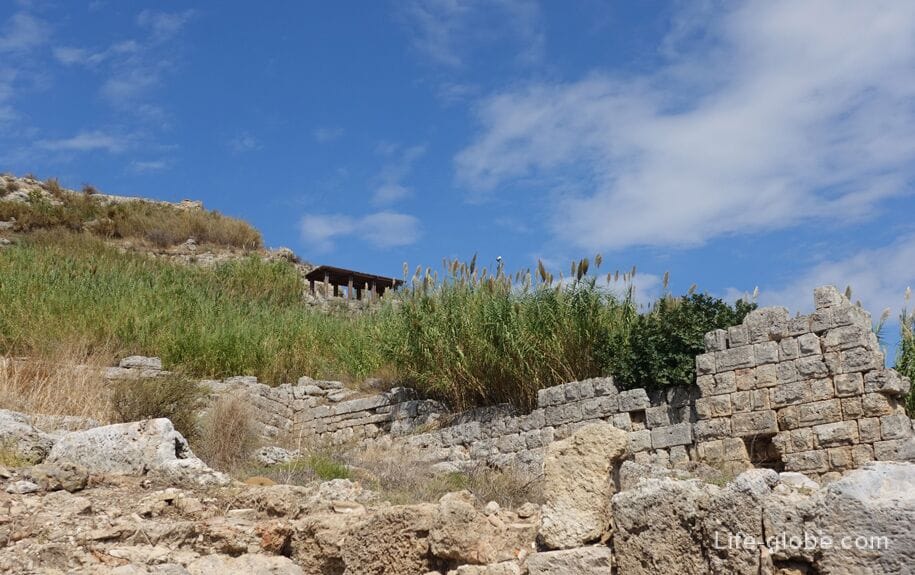
The central Column Street is crossed by the decumanus (city street - oriented from east to west), which connected the western and eastern city gates.
This street is also decorated with colonnades, which previously supported porticos.
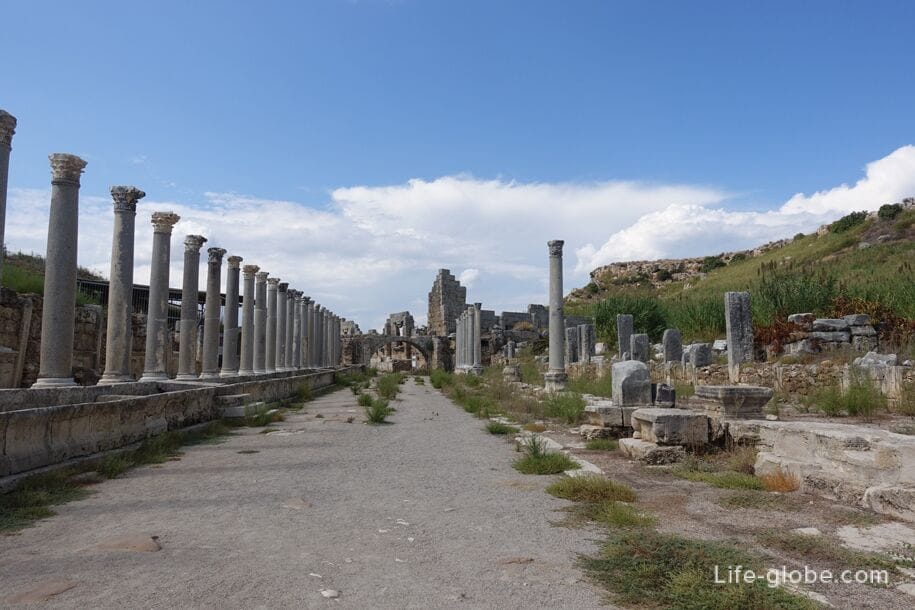



The remains of the arch of Demetrius Apollonius on decumanus.

On the street there are restored mosaics.
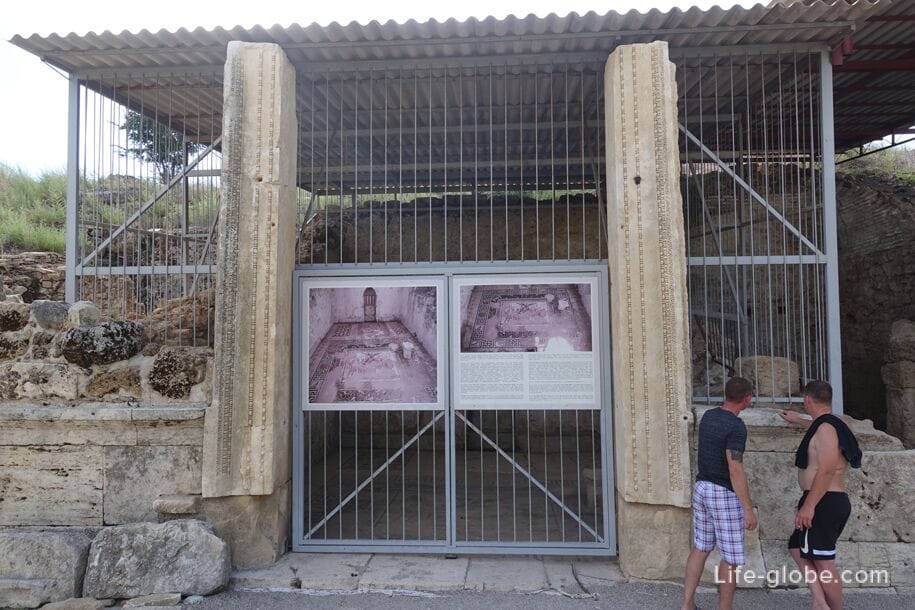
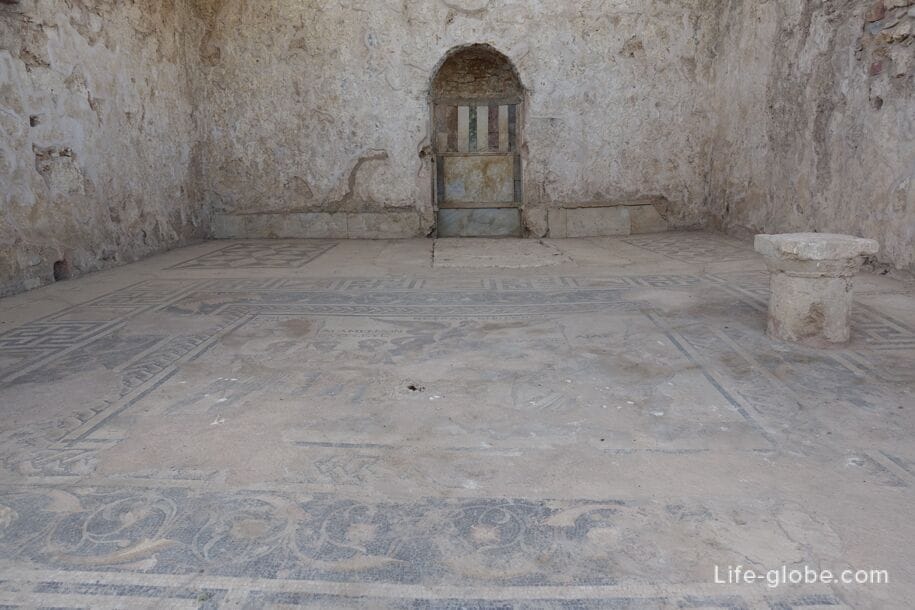
Also on this street you can see the remains of the walls of the gymnasium and some buildings.




In the north-western part of the city on the decumanus there were another - northern baths.
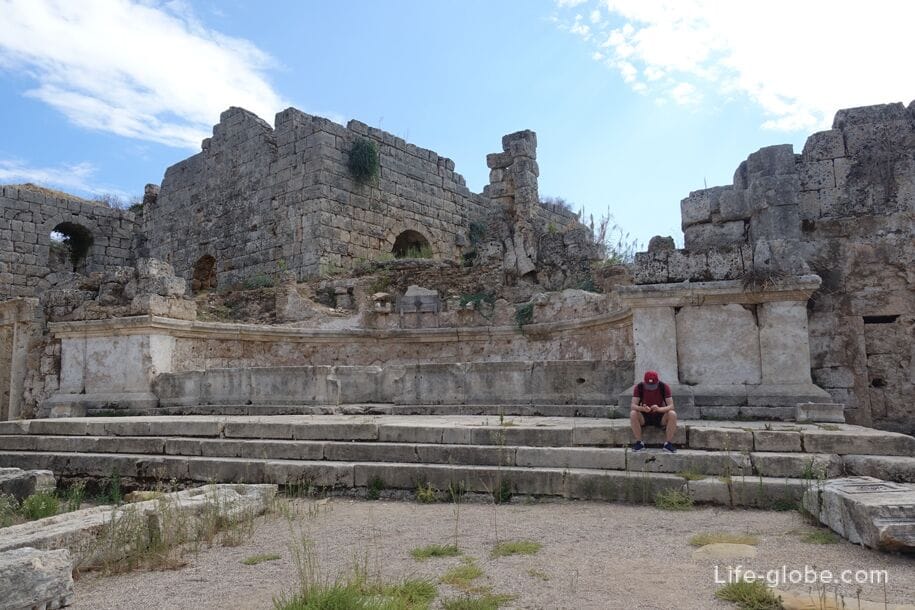

In addition to the ruins, equipment is exhibited in Perga, with the help of which excavations were carried out here in the period from 1973 to 1995.
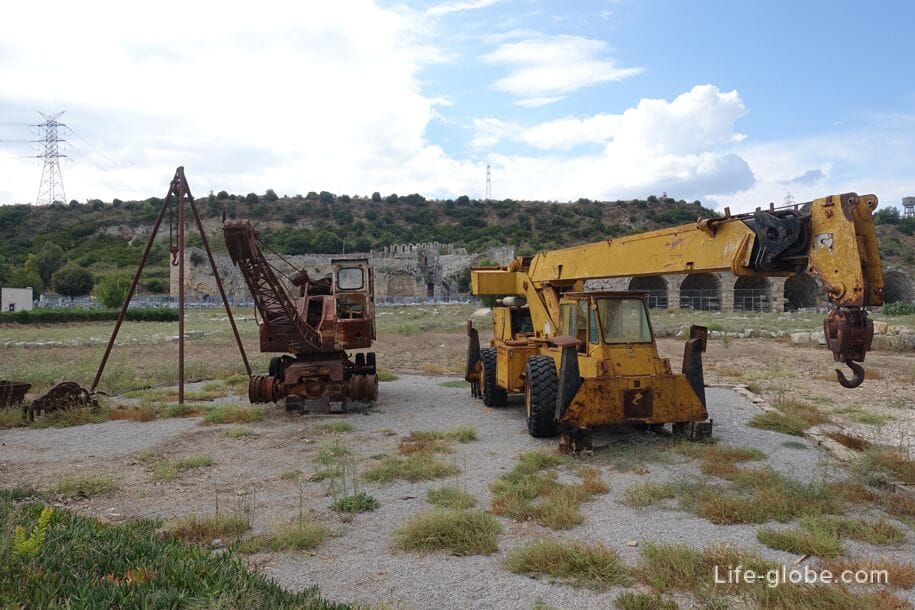
On the territory of the archaeological park-Museum of Perge there is a souvenir shop and a small cafe-snack bar.
In front of the entrance to the archaeological complex there are ticket offices, free toilets, souvenir shops, a three-dimensional model of the recreated city of Perge and parking are displayed.
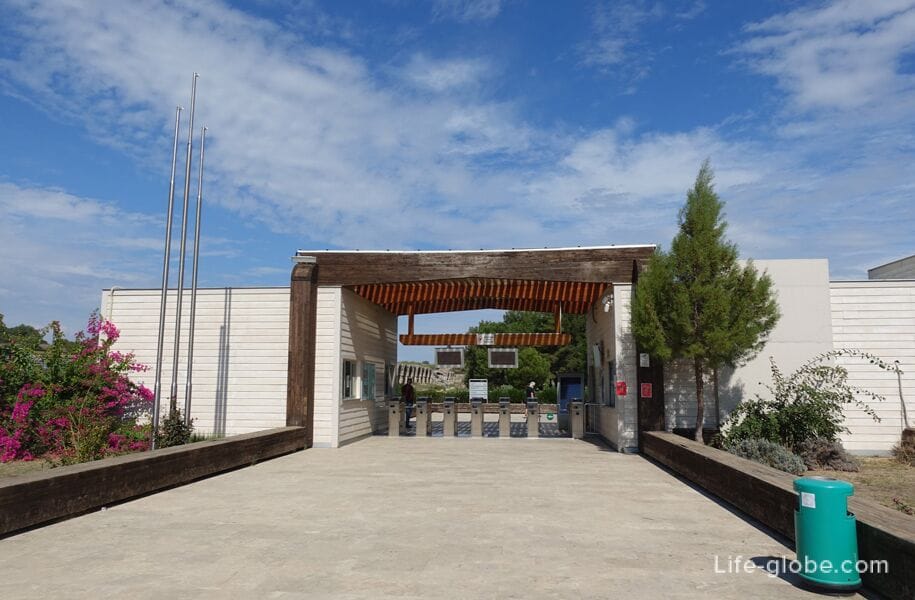
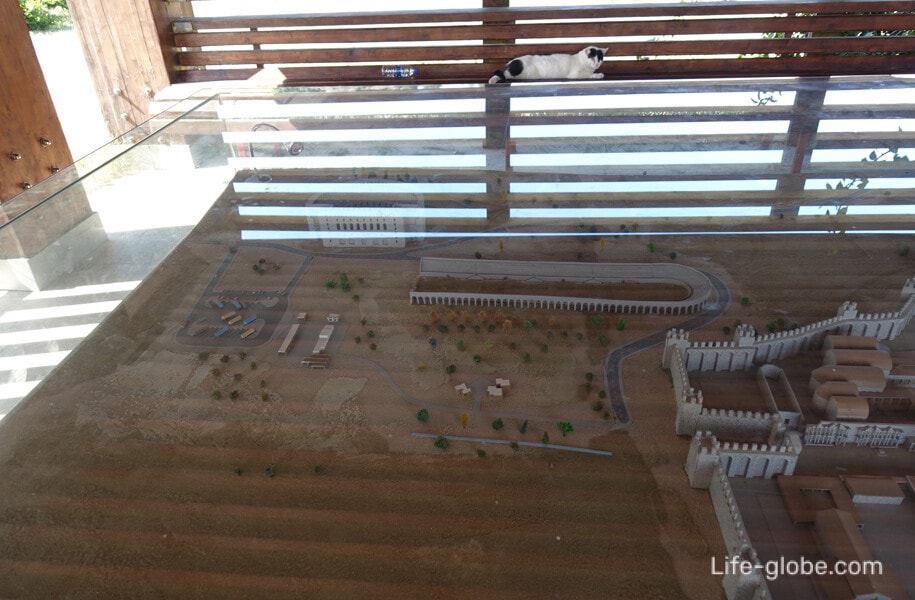
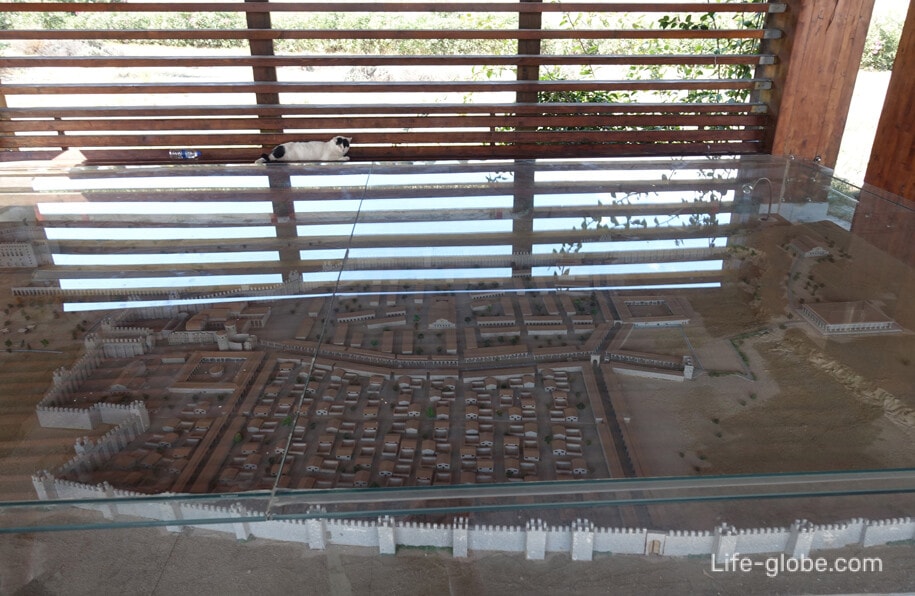
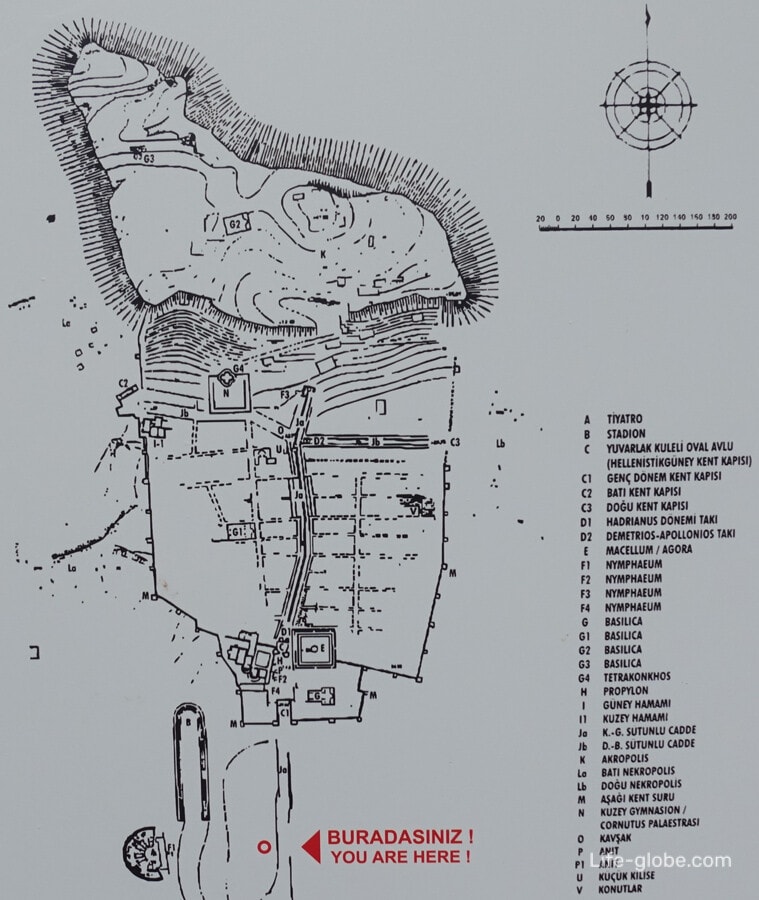
Address of the Archaeological site of Perge: Barbaros Mahallesi Perge Caddesi Aksu, 07112 Aksu/Antalya, Turkey.
Coordinates of Perge: 36°57'37.0"N 30°51'13.0"E (36.960278, 30.853611).
You can get to Perge from the historical center of Antalya by public buses, high-speed tram T1B (stop "Aksu"; the direction of the tram from the center of Antalya in the direction of "EXPO"; the distance from the Aksu tram stop to Perge is about 2 kilometers), taxi or car. Rent a car in Antalya (all places, including the airport and the city center) →
Entrance to the Archaeological Park-Museum of Perge is paid.
There is a Museum card of the Mediterranean (Museum Pass The Mediterranean), according to which admission to some museums and archaeology is free or at a discount.
Tickets and museum cards can be purchased at the ticket offices near Perge. The ticket offices are located both near the entrance to the main complex and near the entrance to the Perge Theater, located across the street.
The site of the archaeological site of Perge: muze.gov.tr/muze-detay.
All accommodation facilities in Antalya (hotels, apartments, villas, guest houses, etc.), including in the historical center of the city, near beaches and more remotely from those, can be view and book here